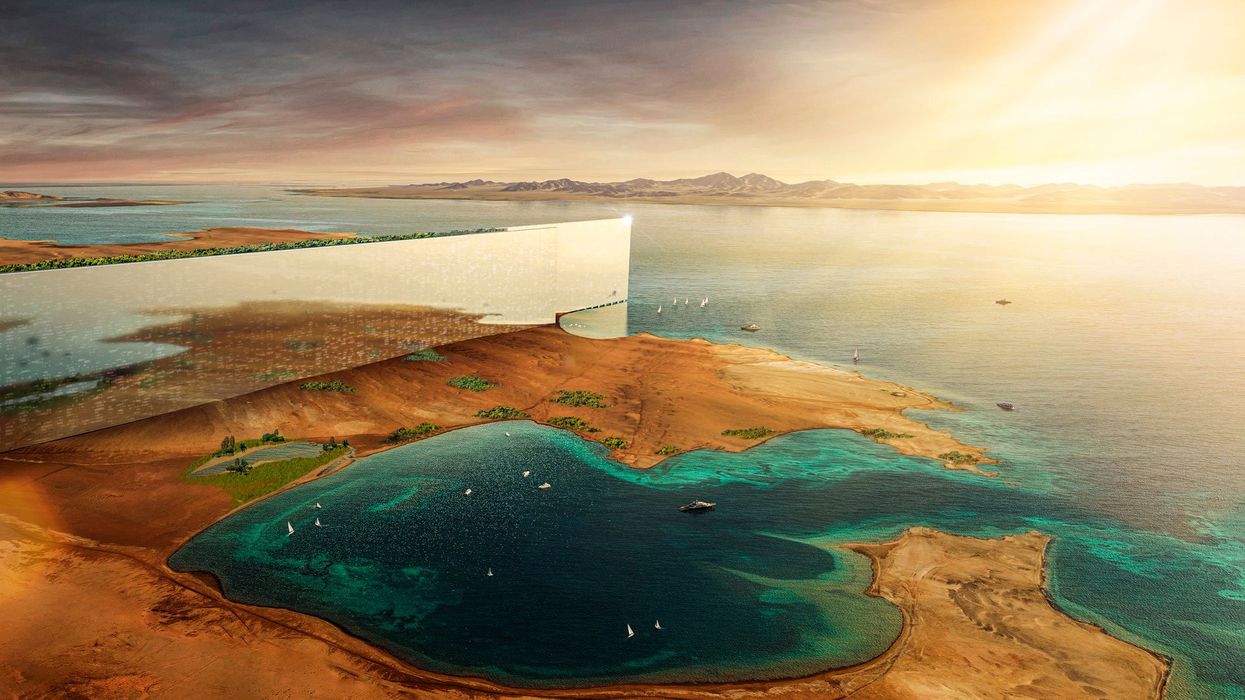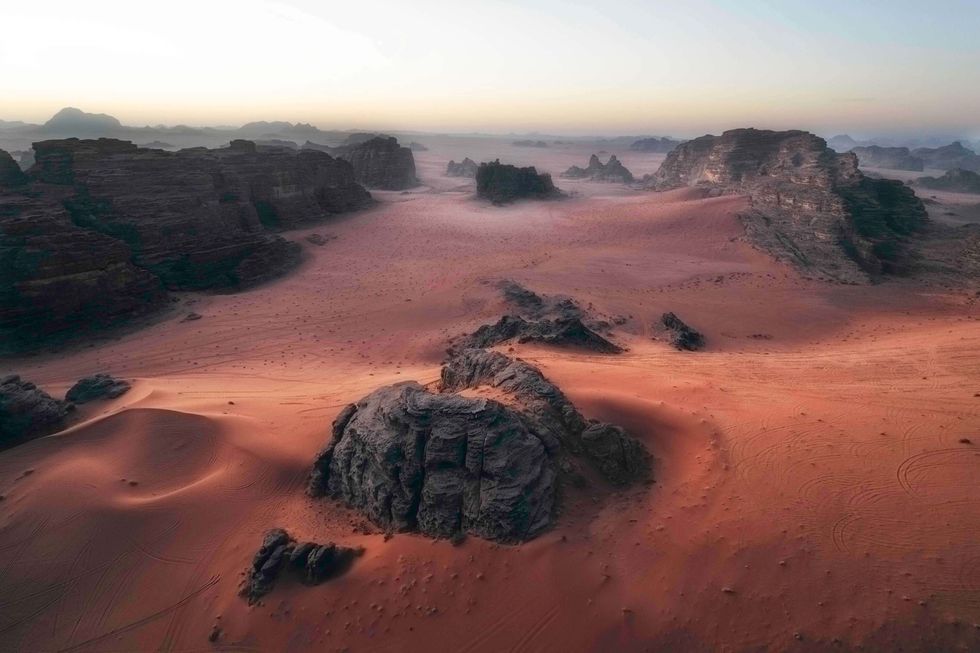
Image courtesy of Neom

When Mohammed bin Salman became crown prince of Saudi Arabia in 2017, he consolidated his power first by imprisoning many of his relatives and other influential Saudis in the Ritz-Carlton. Next, and more unexpectedly, he took steps to liberalize social norms, pushing against Wahabi influence and loosening restrictions on women — allowing them to drive, to name one decree.
These opening gambits of his reign give contrasting but hardly novel impressions of the kind of leadership he wants to forge. They derive from an uncompromising reforming zeal that is alien to and sometimes pined for in more strictly democratic societies. It is the style of the enlightened despot, summarized by the variously attributed maxim as “Everything for the people, nothing by the people.” And six years later, his ambitions for the small but significant petro state are only growing in magnitude and audacity. Indeed, he appears to be placing his entire legacy in the middle of the desert — that is, in Neom.
The city of Neom does not yet exist. A 10,200-square-mile spot of land in the northwestern province of Tabuk is staked out for its development. Much of it was supposed to have been completed by 2020, with full completion by 2025. In 2023, the $500 billion project has broken ground. Most prominent is the Line, a skyscraper that is 110 miles long and can house 9 million people. To many observers, the Line is a comical stroke of hubris, a 21st-century Titanic on sand. In the crown prince’s mind, however, it is a 21st-century pyramid and the key to taking Saudi Arabia into the future.
Transforming Saudi Arabia drives MBS. He wants to wean Saudi Arabia off oil dependence, creating a dynamic, modern economy in the process. Oil accounts for 87% of the Saudi budget and 42% of economic activity. Oil production tends to be dependent on highly skilled foreign labor and technology, and the Saudi state maintains power through a combination of brutality and generous welfare payments. It is, according to journalist Karen Elliott House:
a bewildering (at least to outsiders) combination of a feudal fealty system and a more modern political patronage one. At every level in every sphere of activity, Saudis maneuver through life manipulating individual privileges, favors, obligations, and connections. By the same token, the government bureaucracy is a maze of overlapping or conflicting power centers under the patronage of various royal princes with their own priorities and agendas to pursue and dependents to satisfy.
MBS seeks to remove the need for this complex balancing act by bringing Saudi Arabia into the modern era. Indeed he is a modernizer in the mold of Atatürk, Muhammad Ali, or Peter the Great. He gained power in a society that was backward by the standards of the day, with pressure from more advanced regional and global powers. He is embarking on an effort to modernize Saudi Arabia by changing the underlying social structures to become more effective in the modern world.
Past examples of such efforts come with many encouraging successes. Mustafa Kemal Atatürk created modern Turkey from the remains of the Ottoman Empire and is still revered for doing so, as is Singapore’s Lee Kuan Yew for turning the expelled Malaysian city-state into an independent developed nation. Others have had mixed success, Peter the Great built St. Petersburg and asserted regional hegemony but did not build a governing class that could sustainably compete with Europe. South Korea’s economy accelerated significantly during Park Chung-hee’s nearly two-decade presidency but not without becoming a dictatorial state that got only a brief respite after Park’s assassination by his intelligence chief in 1979. Muhammad Ali’s failure to modernize Egypt in the early 20th century has left him largely forgotten.

Modernization is by definition a herculean task. It is easier when an existing political elite can coordinate to focus on the goal, e.g., Meiji-era Japan. When the political elite cannot coordinate, it requires a powerful central hand. Concentrating power limits the necessary feedback loop to course-correct, as well as having an inherently corrupting element.
MBS’ reform agenda follows Shenzhen and the logic of special jurisdictions more generally. If it is difficult to build political support for national reforms, reform neglected areas instead. Neom is being built in a sparsely populated desert and more or less outside any central power..
Unlike many leaders in the Middle East, MBS appears to have learned at least some of the lessons from Dubai. Most leaders have laid the rise of Dubai on buildings alone; of aesthetics bringing success. In truth they have it backward: Dubai’s architecture is the result rather than the source of its success. Dubai succeeded because it was a relatively liberal entrepot in a region experiencing a natural resource boom. In addition to physical infrastructure, Neom is ensuring a strong legal environment, a “competitive legal framework.” Press releases and public statements always mention the importance of governance.
A lesson they haven’t learned from Dubai is the organic, evolutionary process of development. Dubai succeeded by taking advantage of regional missteps. Iran raises tariffs: Dubai invites Persian traders to use its ports. Iranian Revolution: Dubai’s airport becomes more attractive for layovers. Civil unrest in Lebanon: Dubai positions itself as the financial capital of the Middle East. Cities, much less regions, are not planned from scratch, but instead the result of dynamic, competitive processes. Without a feedback loop — are people and businesses moving to the region? — MBS can easily misspend tens of billions of dollars.
The Line is not Saudi Arabia’s first new city project. King Abdullah Economic City was touted to diversify the country’s economy from oil and create 1 million jobs by 2020. In 2018 the city had 7,000 residents. MBS looked at King Abdullah Economic City and thought, "Not enough money!" Up to $1 trillion will be invested in Neom.
The ambition of Neom at times appears unmoored from reality; it is not lacking for critics. Some ideas that are being advanced in addition to the already baffling Line include a beach with crushed marble for sand. To meet the goals in the promotional video, getting anywhere in the city in just 20 minutes requires trains faster than the fastest maglev trains in operation today. The beach with crushed marble was shelved for not being imaginative enough.
Images from press releases look closer to sci-fi renderings than actual plans. Perhaps this isn’t surprising, as Neom is hiring experts on the aesthetics of "Blade Runner."
Despite my own skepticism, there is still a case to be made for Neom. First, Saudi Arabia faces tremendous challenges in diversifying and modernizing its economy. Second, national reforms could be difficult given religious opposition and other entrenched interests. Third, governments have successfully built cities before, e.g., Washington, D.C.; Abuja; and St. Petersburg. Brasilia even proves that modernist abominations can grow with enough of a helping hand from the government.
But cities are also a series of logistical problems. Chief among them is coordinating, let alone encouraging, mass migration. Overcoming it will take more than a sweeping and singular vision or promises of roadless sustainability in a country whose income is still based on fossil fuels. Moreover, a credible commitment to spend obscene amounts of money on development is only the beginning.
National leaders with grand visions should not be automatic net negatives. Whether they are vindicated in the long term is not ultimately in their hands. The sheer arrogance of Mohammed bin Salman’s designs is impossible to ignore. That he longs for pharaonic greatness is no secret. The best way to be remembered is to build vast structures in deserts. It may be that the crown prince will have his glass pyramid. It remains to be seen whether 9 million people want to entomb themselves within it.
- YouTube youtu.be